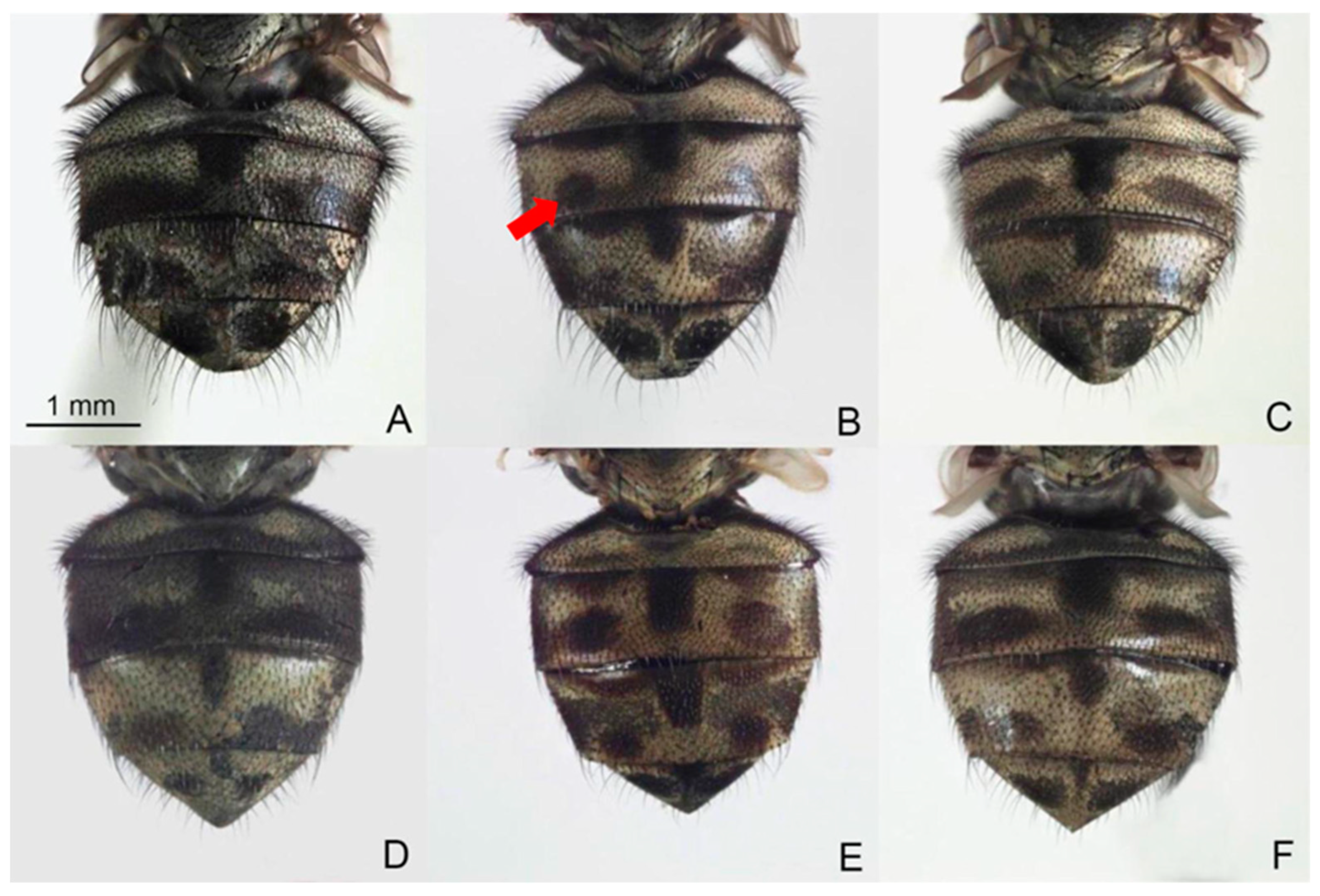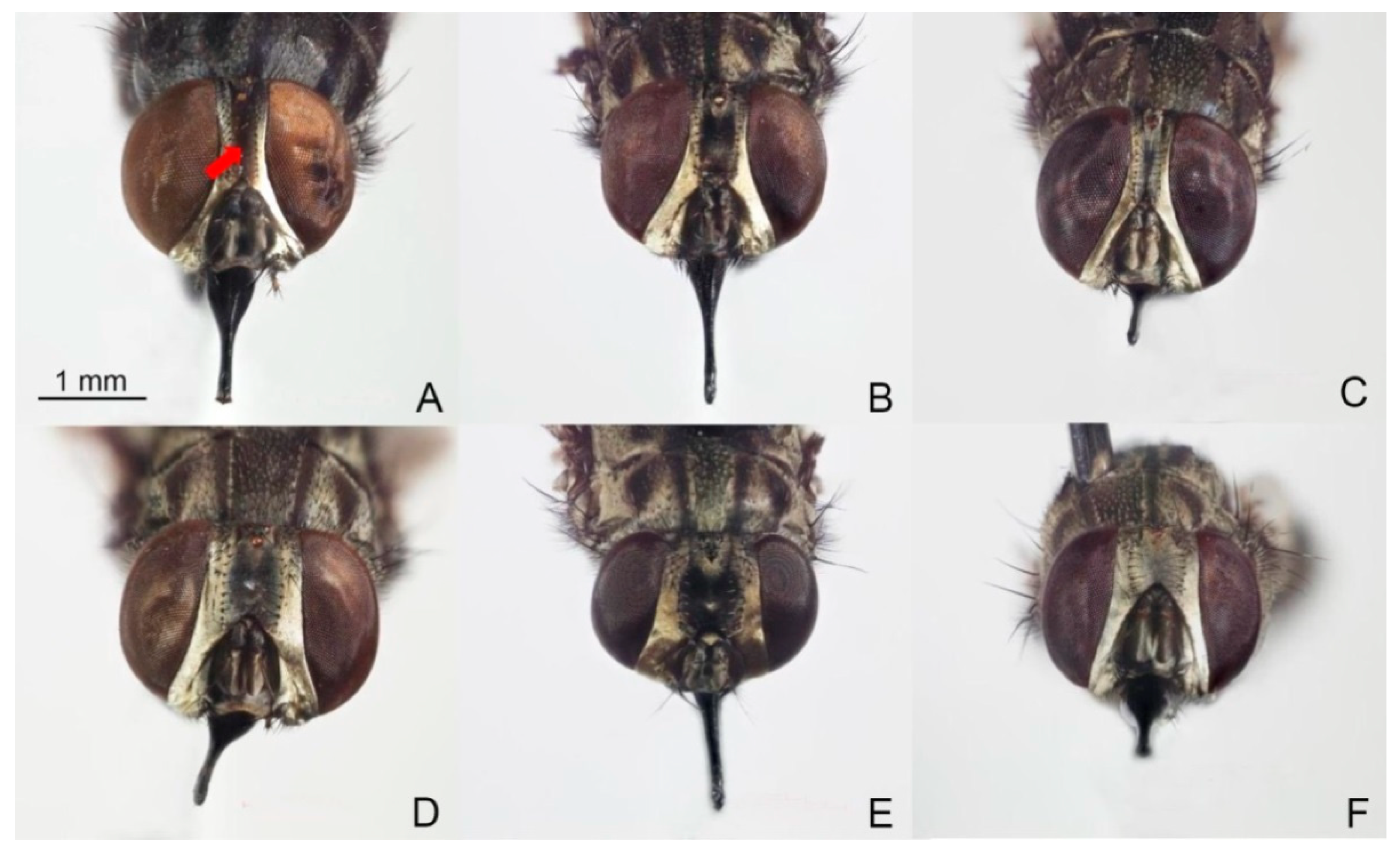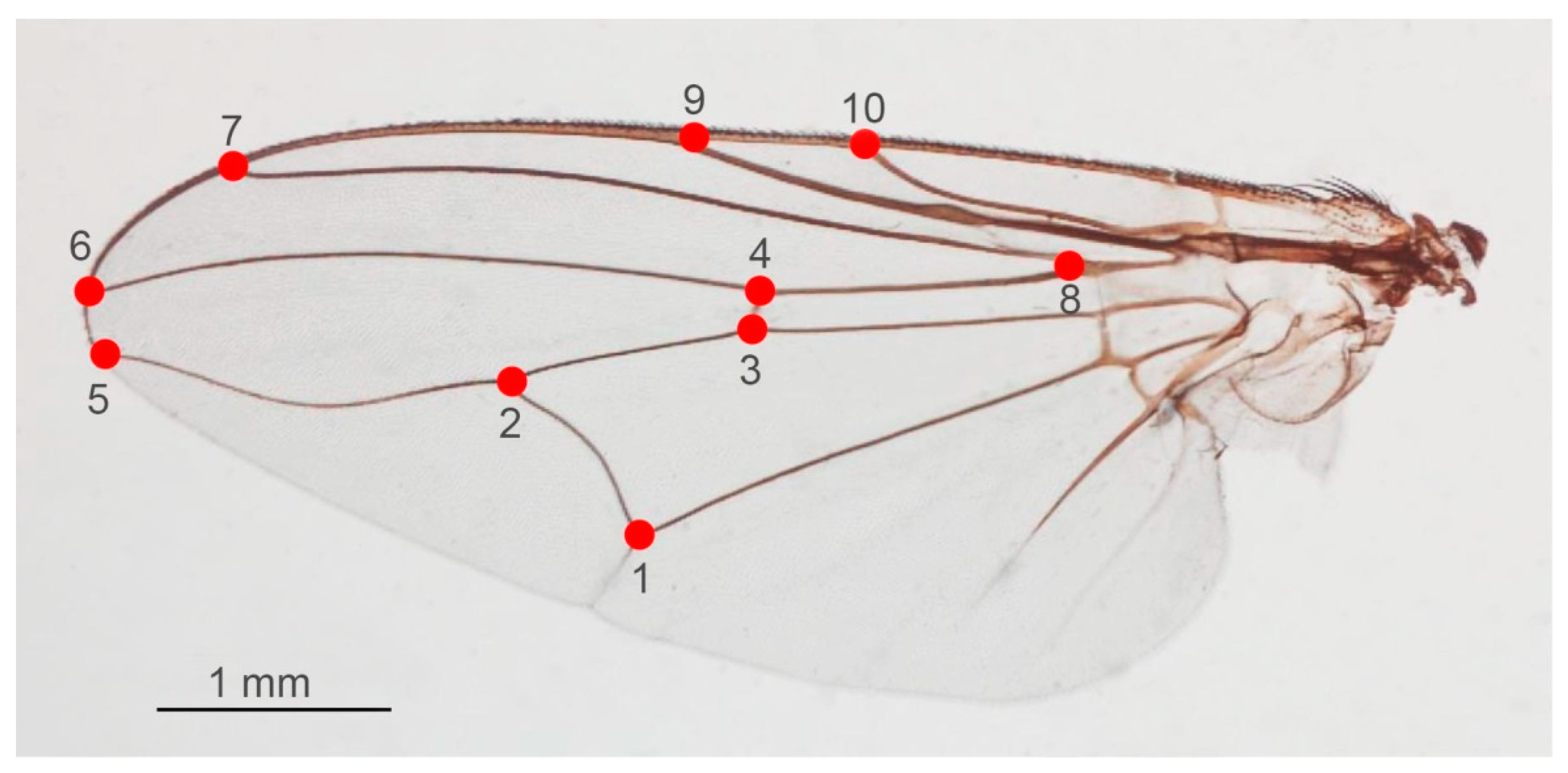Species Discrimination of Stomoxys Flies S. bengalensis, S. calcitrans, and S. sitiens (Diptera: Muscidae) Using Wing Geometric Morphometrics
Abstract
:Simple Summary
Abstract
1. Introduction
2. Materials and Methods
2.1. Ethical Statement
2.2. Specimen Collection and Species Identification
2.3. Specimen Preparation
2.4. Wing Geometric Morphometric Analyses
2.4.1. Landmark Digitization and Digitization Error
2.4.2. Wing Size Analyses
2.4.3. Wing Shape Analyses
2.4.4. Validated Classification Based on Size and Shape
2.4.5. Allometric Effect Analysis
2.4.6. Morphometric Software
3. Results
3.1. Intra-and Inter-User Repeatability
3.2. Wing Size Variation
3.3. Wing Shape Variation
3.4. Validated Classification
3.5. Allometric Effect
4. Discussion
5. Conclusions
Supplementary Materials
Author Contributions
Funding
Institutional Review Board Statement
Informed Consent Statement
Data Availability Statement
Acknowledgments
Conflicts of Interest
References
- Zumpt, F.Z. The Stomoxyine Biting Flies of the World; Gustav Fisher Verlag: Stuttgart, Germany, 1973; pp. 97–137. [Google Scholar]
- Baldacchino, F.; Muenworn, V.; Desquesnes, M.; Desoli, F.; Charoenviriyaphap, T.; Duvallet, G. Transmission of Pathogens by Stomoxys Flies (Diptera, Muscidae): A Review. Parasite 2013, 20, 26. [Google Scholar] [CrossRef]
- Taylor, D.B.; Moon, R.D.; Mark, D.R. Economic Impact of Stable Flies (Diptera: Muscidae) on Dairy and Beef Cattle Production. J. Med. Entomol. 2012, 49, 198–209. [Google Scholar] [CrossRef]
- Changbunjong, T.; Weluwanarak, T.; Ratanakorn, P.; Maneeon, P.; Ganpanakngan, M.; Apiwathnasorn, C.; Sungvornyothin, S.; Sriwichai, P.; Sumruayphol, S.; Ruangsittichai, J. Distribution and Abundance of Stomoxyini flies (Diptera: Muscidae) in Thailand. Southeast Asian J. Trop. Med. Public Health 2012, 43, 1400–1410. [Google Scholar] [PubMed]
- Changbunjong, T.; Weluwanarak, T.; Sedwisai, P.; Chamsai, T. Stomoxyini Fly Fauna of the Khao Yai National Park, Thailand. Asian Pac. J. Trop. Dis. 2013, 3, 348–351. [Google Scholar] [CrossRef]
- Tumrasvin, W.; Shinonaga, S. Studies on medically important flies in Thailand. V. On 32 Species belonging to the Subfamilies Muscinae and Stomoxyinae including the Taxonomic Keys (Diptera: Muscidae). Bull. Tokyo Med. Dent. Univ. 1978, 25, 201–227. [Google Scholar] [PubMed]
- Muenworn, V.; Duvallet, G.; Tainchum, K.; Tuntakom, S.; Tanasilchayakul, S.; Prabaripai, A.; Akratanakul, P.; Sukonthabhirom, S.; Chareonviriyaphap, T. Geographic Distribution of Stomoxyine Flies (Diptera: Muscidae) and Diurnal Activity of Stomoxys calcitrans in Thailand. J. Med. Entomol. 2010, 47, 791–797. [Google Scholar] [CrossRef] [PubMed]
- Masmeatathip, R.; Ketavan, C.; Duvallet, G. Morphological Studies of Stomoxys spp. (Diptera: Muscidae) in Central Thailand. Kasetsart J. 2006, 40, 872–881. [Google Scholar]
- Desquesnes, M.; Holzmuller, P.; Lai, D.H.; Dargantes, A.; Lun, Z.R.; Jittaplapong, S. Trypanosoma evansi and Surra: A review and Perspectives on Origin, History, Distribution, Taxonomy, Morphology, Hosts, and Pathogenic Effects. BioMed Res. Int. 2013, 2013, 194176. [Google Scholar] [CrossRef] [PubMed]
- Saetiew, N.; Stich, R.W.; Jittapalapong, S. Biodiversity of Blood Sucking Flies Associated with the Prevalence of Anaplasma marginale Infection in Dairy Farms in Ratchaburi Province. J. Mahanakorn Vet. Med. 2018, 13, 171–184. [Google Scholar]
- Arjkumpa, O.; Suwannaboon, M.; Boonrod, M.; Punyawan, I.; Liangchaisiri, S.; Laobannue, P.; Lapchareonwong, C.; Sansri, C.; Kuatako, N.; Panyasomboonying, P.; et al. The First Lumpy Skin Disease Outbreak in Thailand (2021): Epidemiological Features and Spatio-Temporal Analysis. Front. Vet. Sci. 2022, 8, 799065. [Google Scholar] [CrossRef] [PubMed]
- Changbunjong, T.; Weluwanarak, T.; Samung, Y.; Ruangsittichai, J. Molecular Identification and Genetic Variation of Stomoxyine flies (Diptera: Muscidae) in Thailand Based on COX1 Barcode. J. Asia Pac. Entomol. 2016, 19, 1117–1123. [Google Scholar] [CrossRef]
- Sevidzem Silas, L.; Kong Anita, B.; Koumba Armel, A.; Zinga Koumba, C.; Mintsa-Nguema, R.; Mavoungou, J.F. Molecular Identification of Stomoxys and Musca (Diptera: Muscidae) of Veterinary Importance in the Pasture Area of Ngaoundere. Acta. Entomol. Zool. 2020, 1, 33–36. [Google Scholar]
- Changbunjong, T.; Sumruayphol, S.; Weluwanarak, T.; Ruangsittichai, J.; Dujardin, J.P. Landmark and Outline-based Geometric Morphometrics Analysis of Three Stomoxys Flies (Diptera: Muscidae). Folia Parasitol. 2016, 63, 37. [Google Scholar] [CrossRef] [PubMed] [Green Version]
- Dujardin, J.P. Morphometrics Applied to Medical Entomology. Infect. Genet. Evol. 2008, 8, 875–890. [Google Scholar] [CrossRef] [PubMed]
- Dujardin, J.P.; Kaba, D.; Solano, P.; Dupraz, M.; McCoy, K.D.; Jaramillo, O.N. Outline-Based Morphometrics, an Overlooked Method in Arthropod Studies? Infect. Genet. Evol. 2014, 28, 704–714. [Google Scholar] [CrossRef] [PubMed]
- Dujardin, S.; Dujardin, J.P. Geometric Morphometrics in the Cloud. Infect. Genet. Evol. 2019, 70, 189–196. [Google Scholar] [CrossRef] [PubMed]
- Sontigun, N.; Sukontason, K.L.; Zajac, B.K.; Zehner, R.; Sukontason, K.; Wannasan, A.; Amendt, J. Wing Morphometrics as a Tool in Species Identification of Forensically Important Blow Flies of Thailand. Parasit. Vectors 2017, 10, 229. [Google Scholar] [CrossRef] [PubMed]
- Sontigun, N.; Samerjai, C.; Sukontason, K.; Wannasan, A.; Amendt, J.; Tomberlin, J.K.; Sukontason, K.L. Wing Morphometric Analysis of Forensically Important Flesh Flies (Diptera: Sarcophagidae) in Thailand. Acta Trop. 2019, 190, 312–319. [Google Scholar] [CrossRef]
- Lorenz, C.; Marques, T.C.; Sallum, M.A.; Suesdek, L. Morphometrical Diagnosis of the Malaria Vectors Anopheles cruzii, An. homunculus and An. bellator. Parasit. Vectors 2012, 5, 257. [Google Scholar] [CrossRef] [PubMed]
- Martinet, J.-P.; Ferté, H.; Sientzoff, P.; Krupa, E.; Mathieu, B.; Depaquit, J. Wing Morphometrics of Aedes Mosquitoes from North-Eastern France. Insects 2021, 12, 341. [Google Scholar] [CrossRef] [PubMed]
- De Souza, A.L.D.S.; Multini, L.C.; Marrelli, M.T.; Wilke, A.B.B. Wing Geometric Morphometrics for Identification of Mosquito Species (Diptera: Culicidae) of Neglected Epidemiological Importance. Acta Trop. 2020, 211, 105593. [Google Scholar] [CrossRef]
- Chaiphongpachara, T.; Changbunjong, T.; Sumruayphol, S.; Laojun, S.; Suwandittakul, N.; Kuntawong, K. Geometric Morphometrics Versus DNA Barcoding for the Identification of Malaria Vectors Anopheles dirus and An. baimaii in the Thai-Cambodia border. Sci. Rep. 2022, 12, 13236. [Google Scholar] [CrossRef] [PubMed]
- Simões, R.F.; Wilke, A.B.B.; Chagas, C.R.F.; Menezes, R.M.T.d.; Suesdek, L.; Multini, L.C.; Silva, F.S.; Grech, M.G.; Marrelli, M.T.; Kirchgatter, K. Wing Geometric Morphometrics as a Tool for the Identification of Culex Subgenus Mosquitoes of Culex (Diptera: Culicidae). Insects 2020, 11, 567. [Google Scholar] [CrossRef] [PubMed]
- Ruangsittichai, J.; Apiwathnasorn, C.; Dujardin, J.P. Interspecific and Sexual Shape Variation in the Filariasis Vectors Mansonia dives and Ma. bonneae. Infect. Genet. Evol. 2011, 11, 2089–2094. [Google Scholar] [CrossRef] [PubMed]
- Laojun, S.; Changbunjong, T.; Chaiphongpachara, T. Evaluation of Modern Techniques for Species Identification of Lutzia Mosquitoes (Diptera: Culicidae) in Thailand: Geometric Morphometrics and DNA Barcoding. Insects 2023, 14, 78. [Google Scholar] [CrossRef] [PubMed]
- Dujardin, J.P.; Le Pont, F.; Baylac, M. Geographical versus Interspecific Differentiation of Sand Flies (Diptera: Psychodidae): A landmark Data Analysis. Bull. Entomol. Res. 2003, 93, 87–90. [Google Scholar] [CrossRef] [PubMed]
- Giordani, B.F.; Andrade, A.J.; Galati, E.A.B.; Gurgel-Gonçalves, R. The Role of Wing Geometric Morphometrics in the Identification of Sand Flies within the Subgenus Lutzomyia. Med. Vet. Entomol. 2017, 31, 373–380. [Google Scholar] [CrossRef]
- Kaba, D.; Berté, D.; Ta, B.T.; Tellería, J.; Solano, P.; Dujardin, J.P. The Wing Venation Patterns to Identify Single Tsetse Flies. Infect.Genet. Evol. 2017, 47, 132–139. [Google Scholar] [CrossRef] [PubMed]
- Changbunjong, T.; Prakaikowit, N.; Maneephan, P.; Kaewwiset, T.; Weluwanarak, T.; Chaiphongpachara, T.; Dujardin, J.P. Landmark Data to Distinguish and Identify Morphologically Close Tabanus spp. (Diptera: Tabanidae). Insects 2021, 12, 974. [Google Scholar] [CrossRef] [PubMed]
- Gumiel, M.; Catalá, S.; Noireau, F.; Rojas de Arias, A.; Garcia, A.; Dujardin, J. Wing geometry in Triatoma infestans (Klug) and T. melanosoma Martinez, Olmedo & Carcavallo (Hemiptera: Reduviidae). Syst. Entomol. 2003, 28, 173–180. [Google Scholar]
- Laveissiere, C.; Grebaut, P. The Trapping of Tsetse Flies (Diptera: Glossinidae) Improvement of a Model: The Vavoua Trap. Trop. Med. Parasitol. 1990, 41, 185–192. [Google Scholar] [PubMed]
- Klingenberg, C.P.; McIntyre, G.S. Geometric Morphometrics of Developmental Instability: Analyzing Patterns of Fluctuating Asymmetry with Procrustes Methods. Evolution 1998, 52, 1363–1375. [Google Scholar] [CrossRef]
- Bookstein, F.L. Morphometric Tools for Landmark Data. Geometry and Biology; Cambridge University Press: Cambridge, UK, 1991. [Google Scholar]
- Rohlf, F.J. Rotational fit (Procrustes) methods. In Proceedings of the Michigan Morphometrics Workshop; University of Michigan Museum of Zoology: Ann Arbor, MI, USA, 1990; pp. 227–236. [Google Scholar]
- Dujardin, J.P.; Dujardin, S.; Kaba, D.; Santillán-Guayasamín, S.; Villacís, A.G.; Piyaselakul, S.; Sumruayphol, S.; Samung, Y.; Morales-Vargas, R. The Maximum Likelihood Identification Method Applied to Insect Morphometric Data. Zool. Syst. 2017, 42, 46–58. [Google Scholar]
- Manly, B.F.J. Multivariate Statistical Methods: A Primer; Chapman Hall/CRC Press: Boca Raton, FL, USA, 2004. [Google Scholar]
- Phasuk, J.; Prabaripai, A.; Chareonviriyaphap, T. A Comparison of Attractants for Sampling Stomoxys calcitrans (Diptera: Muscidae) on Dairy Farms in Saraburi Province, Thailand. J. Econ. Entomol. 2016, 109, 942–946. [Google Scholar] [CrossRef] [PubMed]
- Chaiphongpachara, T.; Duvallet, G.; Changbunjong, T. Wing Phenotypic Variation among Stomoxys calcitrans (Diptera: Muscidae) Populations in Thailand. Insects 2022, 13, 405. [Google Scholar] [CrossRef] [PubMed]
- Baleba, S.B.S.; Masiga, D.; Torto, B.; Weldon, C.W.; Getahun, M.N. Effect of Larval Density and Substrate Quality on the Wing Geometry of Stomoxys calcitrans L. (Diptera: Muscidae). Parasit. Vectors 2019, 12, 222. [Google Scholar] [CrossRef]
- Sauer, F.G.; Jaworski, L.; Erdbeer, L.; Heitmann, A.; Schmidt-Chanasit, J.; Kiel, E.; Lühken, R. Geometric Morphometric Wing Analysis Represents a Robust Tool to Identify Female Mosquitoes (Diptera: Culicidae) in Germany. Sci. Rep. 2020, 10, 17613. [Google Scholar] [CrossRef] [PubMed]










| Species | Month | District/Province | Region | Collection Sites | n |
|---|---|---|---|---|---|
| S. bengalensis | May | Mueang, Nakhon Pathom (N 14°01′10″, E 99°57′37″) | Central | Cattle farm and horse farm | Male 45, Female 45 |
| July | Sam Khok, Pathum Thani (N 14°04′46″, E 100°31′51″) | Central | Cattle farm | Male 10, Female 20 | |
| S. calcitrans | May | Mueang, Nakhon Pathom (N 14°01′10″, E 99°57′37″) | Central | Cattle farm and horse farm | Male 25, Female 25 |
| July | Sam Khok, Pathum Thani (N 14°04′46″, E 100°31′51″) | Central | Cattle farm | Male 25, Female 25 | |
| November | Kaeng Khoi, Saraburi (N 14°28′39″, E 101°05′33″) | Central | Horse farm | Male 25, Female 25 | |
| S. sitiens | May | Mueang, Nakhon Pathom (N 14°01′10″, E 99°57′37″) | Central | Cattle farm and horse farm | Male 50, Female 50 |
| November | Kaeng Khoi, Saraburi (N 14°28′39″, E 101°05′33″) | Central | Horse farm | Male 25, Female 30 | |
| Total | 425 |
| Species | n | Mean (mm) | Min–Max | Variance | SD |
|---|---|---|---|---|---|
| Male | |||||
| S. bengalensis | 55 | 4.83 a | 4.45–5.13 | 0.03 | 0.17 |
| S. calcitrans | 75 | 4.23 b | 3.63–4.64 | 0.04 | 0.22 |
| S. sitiens | 75 | 4.32 b | 3.91–4.69 | 0.03 | 0.16 |
| Female | |||||
| S. bengalensis | 65 | 4.76 a | 4.20–5.18 | 0.04 | 0.19 |
| S. calcitrans | 75 | 4.35 b | 3.77–4.79 | 0.04 | 0.20 |
| S. sitiens | 80 | 4.36 b | 3.72–4.83 | 0.05 | 0.23 |
| Species | S. bengalensis | S. calcitrans | S. sitiens |
|---|---|---|---|
| Male | |||
| S. bengalensis | - | <0.001 | <0.001 |
| S. calcitrans | 7.33 | - | <0.001 |
| S. sitiens | 5.06 | 6.71 | - |
| Female | |||
| S. bengalensis | - | <0.001 | <0.001 |
| S. calcitrans | 5.46 | - | <0.001 |
| S. sitiens | 5.71 | 3.42 | - |
| Species | Size | Shape | ||
|---|---|---|---|---|
| % Accuracy | Assigned/Observed | % Accuracy | Assigned/Observed | |
| Male | ||||
| S. bengalensis | 89.09 | 49/55 | 100 | 55/55 |
| S. calcitrans | 58.67 | 44/75 | 100 | 75/75 |
| S. sitiens | 48.00 | 36/75 | 100 | 75/75 |
| Total | 62.93 | 129/205 | 100 | 205/205 |
| Female | ||||
| S. bengalensis | 86.15 | 56/65 | 100 | 65/65 |
| S. calcitrans | 13.33 | 10/75 | 97.33 | 73/75 |
| S. sitiens | 66.25 | 53/80 | 93.75 | 75/80 |
| Total | 54.10 | 119/220 | 96.82 | 213/220 |
Disclaimer/Publisher’s Note: The statements, opinions and data contained in all publications are solely those of the individual author(s) and contributor(s) and not of MDPI and/or the editor(s). MDPI and/or the editor(s) disclaim responsibility for any injury to people or property resulting from any ideas, methods, instructions or products referred to in the content. |
© 2023 by the authors. Licensee MDPI, Basel, Switzerland. This article is an open access article distributed under the terms and conditions of the Creative Commons Attribution (CC BY) license (https://creativecommons.org/licenses/by/4.0/).
Share and Cite
Changbunjong, T.; Chaiphongpachara, T.; Weluwanarak, T. Species Discrimination of Stomoxys Flies S. bengalensis, S. calcitrans, and S. sitiens (Diptera: Muscidae) Using Wing Geometric Morphometrics. Animals 2023, 13, 647. https://doi.org/10.3390/ani13040647
Changbunjong T, Chaiphongpachara T, Weluwanarak T. Species Discrimination of Stomoxys Flies S. bengalensis, S. calcitrans, and S. sitiens (Diptera: Muscidae) Using Wing Geometric Morphometrics. Animals. 2023; 13(4):647. https://doi.org/10.3390/ani13040647
Chicago/Turabian StyleChangbunjong, Tanasak, Tanawat Chaiphongpachara, and Thekhawet Weluwanarak. 2023. "Species Discrimination of Stomoxys Flies S. bengalensis, S. calcitrans, and S. sitiens (Diptera: Muscidae) Using Wing Geometric Morphometrics" Animals 13, no. 4: 647. https://doi.org/10.3390/ani13040647
APA StyleChangbunjong, T., Chaiphongpachara, T., & Weluwanarak, T. (2023). Species Discrimination of Stomoxys Flies S. bengalensis, S. calcitrans, and S. sitiens (Diptera: Muscidae) Using Wing Geometric Morphometrics. Animals, 13(4), 647. https://doi.org/10.3390/ani13040647







